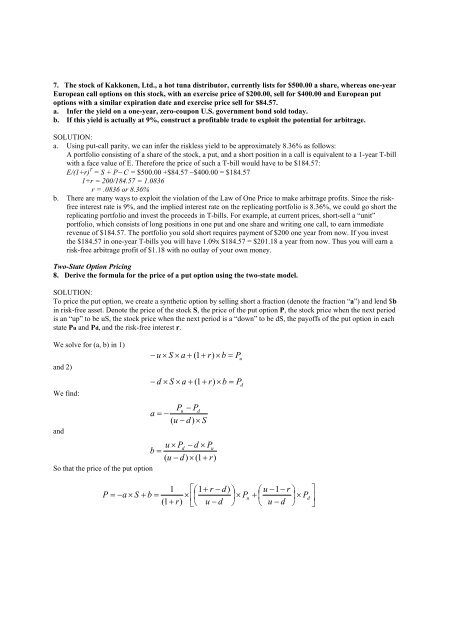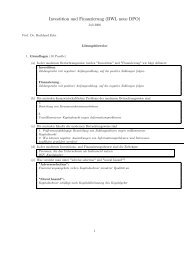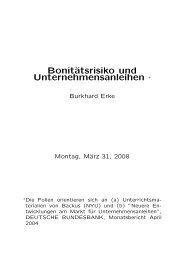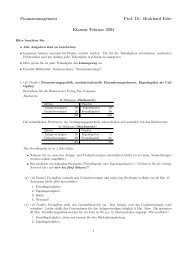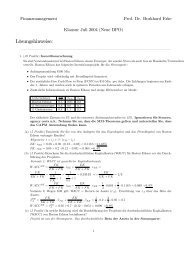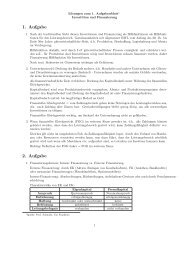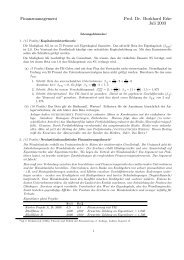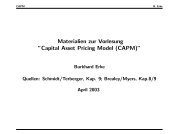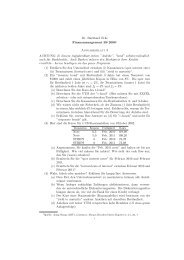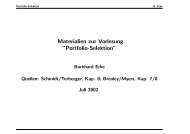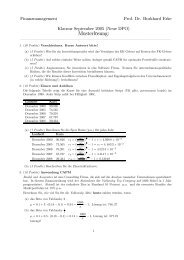Short a Put - Burkhard Erke
Short a Put - Burkhard Erke
Short a Put - Burkhard Erke
You also want an ePaper? Increase the reach of your titles
YUMPU automatically turns print PDFs into web optimized ePapers that Google loves.
7. The stock of Kakkonen, Ltd., a hot tuna distributor, currently lists for $500.00 a share, whereas one-year<br />
European call options on this stock, with an exercise price of $200.00, sell for $400.00 and European put<br />
options with a similar expiration date and exercise price sell for $84.57.<br />
a. Infer the yield on a one-year, zero-coupon U.S. government bond sold today.<br />
b. If this yield is actually at 9%, construct a profitable trade to exploit the potential for arbitrage.<br />
SOLUTION:<br />
a. Using put-call parity, we can infer the riskless yield to be approximately 8.36% as follows:<br />
A portfolio consisting of a share of the stock, a put, and a short position in a call is equivalent to a 1-year T-bill<br />
with a face value of E. Therefore the price of such a T-bill would have to be $184.57:<br />
E/(1+r) T = S + P− C = $500.00 +$84.57 −$400.00 = $184.57<br />
1+r = 200/184.57 = 1.0836<br />
r = .0836 or 8.36%<br />
b. There are many ways to exploit the violation of the Law of One Price to make arbitrage profits. Since the riskfree<br />
interest rate is 9%, and the implied interest rate on the replicating portfolio is 8.36%, we could go short the<br />
replicating portfolio and invest the proceeds in T-bills. For example, at current prices, short-sell a “unit”<br />
portfolio, which consists of long positions in one put and one share and writing one call, to earn immediate<br />
revenue of $184.57. The portfolio you sold short requires payment of $200 one year from now. If you invest<br />
the $184.57 in one-year T-bills you will have 1.09x $184.57 = $201.18 a year from now. Thus you will earn a<br />
risk-free arbitrage profit of $1.18 with no outlay of your own money.<br />
Two-State Option Pricing<br />
8. Derive the formula for the price of a put option using the two-state model.<br />
SOLUTION:<br />
To price the put option, we create a synthetic option by selling short a fraction (denote the fraction “a”) and lend $b<br />
in risk-free asset. Denote the price of the stock S, the price of the put option P, the stock price when the next period<br />
is an “up” to be uS, the stock price when the next period is a “down” to be dS, the payoffs of the put option in each<br />
state Pu and Pd, and the risk-free interest r.<br />
We solve for (a, b) in 1)<br />
and 2)<br />
We find:<br />
and<br />
− u × S × a + (1 + r)<br />
× b =<br />
− d × S × a + (1 + r)<br />
× b =<br />
Pu<br />
− Pd<br />
a = −<br />
( u − d)<br />
× S<br />
u × Pd<br />
− d × Pu<br />
b =<br />
( u − d)<br />
× (1 + r)<br />
So that the price of the put option<br />
P<br />
1 ⎡⎛1+<br />
r − d)<br />
⎞ ⎛ u −1−<br />
r ⎞<br />
−a<br />
× S + b = × ⎢⎜<br />
⎟× Pu<br />
+ ⎜ ⎟× P<br />
(1 + r)<br />
⎣⎝<br />
u − d ⎠ ⎝ u − d ⎠<br />
=<br />
d<br />
P u<br />
P d<br />
⎤<br />
⎥<br />
⎦


